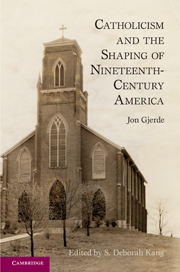Book contents
Introduction
Published online by Cambridge University Press: 05 June 2012
Summary
How odd that “the City of Brotherly Love,” observed the New Englander and Yale Review in 1844, was the site of violence and bloodshed, “the scene of action, as a burlesque upon the name.” Although nearly every major city in the United States had been disgraced by riots of one form or another in the 1830s and 1840s, Philadelphia had been in a league of its own. Riots against abolitionists in 1834 were followed by periodic violence aimed at the African American community in the 1830s and 1840s that drove many black families out of the city and made the situation for those black residents who remained increasingly unpredictable. Philadelphia was the scene of violence again, in 1840, when the Philadelphia and Trenton Railroad intruded into a residential community and was destroyed, and, four years later, when a weavers’ strike turned violent. Philadelphia by the early 1840s clearly had gained “the unenviable distinction” as “the theatre of popular tumults.”
Yet the residents of the City of Brotherly Love outdid themselves in May and July of 1844, when Catholics and Protestants squared off for three days of violence, mayhem, and murder that both scarred the city and provoked reflection about the state of affairs in the polyglot cities of the American Northeast (see Fig. 1). The air was tense in Philadelphia in the weeks leading up to the riots. The region had been recently plagued by controversies concerning the role of religion in the public schools in the early 1840s. The recent electoral successes in New York of a nativist political party, dubbed the Native American Party, further inflamed native-born Philadelphians, who on April 15, 1844, resolved both to emulate their counterparts in New York and, more ominously, to gather again in the largely Irish Third Ward of Philadelphia’s Kensington suburb in early May. Ostensibly, the demonstration was focused on Kensington because it had been the site of outrages that had previously disgraced the city. The more probable reason for the invasion was simply to inflame the tensions raging between the Native American Party supporters and their Irish opponents.
- Type
- Chapter
- Information
- Publisher: Cambridge University PressPrint publication year: 2011



